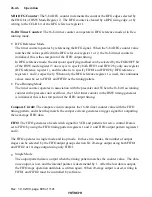
Rev. 1.0, 02/00, page 618 of 1141
26.6
Drum Speed Error Detector
26.6.1
Overview
Drum speed error control holds the drum at a constant revolution speed, by measuring the period
of the DFG signal. A digital counter detects the speed error against a preset value. The speed
error data is processed and added to phase error data in a digital filter. This filter controls a pulse-
width modulated (PWM) output, which controls the revolution speed and phase of the drum.
The DFG input signal is reshaped into a square wave by a reshaping circuit, and sent to the speed
error detector as the DFG signal.
The speed error detector uses the system clock to measure the period of the DFG signal, and
detects the error against a preset data value. The preset data is the value that results from
measuring the DFG signal period with the clock signal when the drum motor is running at the
correct speed.
The error detector operates by latching a counter value when it detects an edge of the DFG signal.
The latched count provides 16 bits of speed error data for the digital filter to operate on. The
digital filter processes and adds the speed error data to phase error data from the drum phase
control system, then sends the result to the PWM as drum error data.
26.6.2
Block Diagram
Figure 26.27 shows a block diagram of the drum speed error detector.
















































